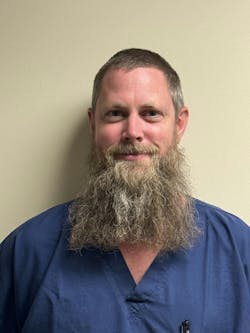Key Considerations for Transitioning Scopes from HLD to Sterilization
It has been over two years since publication of the American National Standards Institute (ANSI)/Advancement of Medical Instrumentation (AAMI) ST91:2021 Flexible and semi-rigid endoscope processing in health care facilities standard. What progress have healthcare organizations made in transitioning high-risk endoscopes – and other scopes - from high level disinfection (HLD) to sterilization as the standard of care?
Healthcare Purchasing News (HPN) reached out to sterile processing (SP) professionals for their insights on the topic, where we are today, and key factors when considering a change from HLD to a sterilization modality.
Current state of scope sterilization
“There was a lot of talk in general around scopes and endoscopy during the Healthcare Sterile Processing Association (HSPA) 2024 Annual Conference, with sterilization being a big topic of discussion,” said Ash Crowe, director, Healthcare at St. Onge Company. “There is a push for manufacturers to design more scopes to be capable of sterilization.”
“From a patient perspective, sterile is better than disinfected,” Crowe added. “If I were going in for a procedure, I too would prefer it if my scope had been sterilized. I think everyone understands that, but then there is the challenge of how do you make that happen? How do you integrate more sterilized scopes into your workflows?”
While “evidence supports the sterilization of all flexible endoscopes, including those used in both semi-critical and critical procedures,”1 even those healthcare organizations that want to standardize on flexible scope sterilization face the challenge of manufacturer instructions for use (IFU) that recommend only HLD for their products.
Some healthcare organizations that choose to continue HLD when given a choice in the scope manufacturers’ IFUs between HLD and sterilization take this route because they lack the resources to sterilize all scopes that can be sterilized. For example, they don’t have the recommended sterilization modality available, or the SP department simply can’t handle the added sterilization volume given staffing, equipment, and space constraints.
The issue of ethylene oxide (EtO)
“As we know, flexible endoscopes are heat sensitive, so not compatible with steam and other sterilization modalities,” said John Whelan, BSN, RN, clinical education specialist, Healthmark, a Getinge company. “EtO sterilization, while compatible with many endoscopes, is not available to many facilities.”
The U.S. Environmental Protection Agency’s (EPA) March 14, 2024, issuance of its final rule to sharply cut toxic emissions of EtO marks one of the latest initiatives driving healthcare facilities to transition from EtO to alternative low-temperature sterilization methodologies.2
“We have transitioned from HLD to terminal sterilization for some items, including bronchoscopes and obviously cystoscopes, which have always been terminally sterilized, and we are removing EtO as a sterilizer modality as we speak,” said Sean Weir, CRCST, CIS, CER, CHL, system sterile processing educator, UPMC.
But some manufacturers of flexible gastrointestinal (GI) endoscopes still recommend EtO sterilization in their IFUs.
“In my previous role, we transitioned all bronchoscopes, cystoscopes, and ureteroscopes from HLD to sterilization,” noted Hannah Schroeder, BSHA, CRCST, CHL, CIS, CER, clinical education specialist, Pure Processing. “We did not move GI scopes out of HLD because many of the manufacturers’ IFUs still indicate EtO as a recommended sterilant.”
“Even for a facility that has EtO, that cycle length is incredibly long, about 15 hours just in the sterilization chamber, so it is really not feasible for many facilities to go from HLD to sterilization for their GI scopes,” she added.
As Whelan pointed out, there are other sterilization options available beyond EtO for heat sensitive, flexible endoscopes if these modalities are recommended by manufacturers in their IFUs. He stated:
“Many scopes that are used in OR settings (e.g., ureteroscopes, cystoscopes, and bronchoscopes) already have compatibility with commonly available sterilization modalities (e.g., Sterrad).”
Recommendations for transitioning from HLD to sterilization
“Transitioning from HLD to sterilization is not a simple process,” said Schroeder. “We all love the idea of it because it is a safer alternative, but getting there is a puzzle and journey.”
“It can be a slow evolution because it's not something you can do immediately,” said Stacy Johnson, APRN, CNS, CNOR, CCSVP, clinical education consultant, ASP. She noted how the move from HLD to sterilization requires stakeholders, including department managers, and infection prevention (IP) and SP professionals coming together to determine whether change is feasible. She added how vendor partners are another critical stakeholder in the mix as they can work alongside SP and clinical teams to provide support.
Schroeder, Johnson, and the other SP professionals interviewed for this article offered their recommendations and best practices for healthcare organizations considering a transition from HLD to sterilization for scopes that can be processed in this manner.
Form a multidisciplinary team
When it comes to who should be involved with decisions around scope HLD versus sterilization, Whelan suggests healthcare organizations “utilize a multidisciplinary team to review current state and provide input for proposed changes. This team should minimally include processing professionals, infection prevention, customer clinicians, and administration.”
Weir emphasized the importance of collaboration among SP and IP teams regardless of the scope reprocessing modality, telling other SP leaders:
“If you don’t talk to your infection preventionists at least weekly, you need to reconnect. In my hospital, our infection preventionist and I have each other’s cell phone numbers so we can text questions back and forth. You’ve got to have a great relationship with your IP team. They are your biggest supporters on surveys and for compliance.”
Assess scope inventory
As Whelan stated: “Start with a detailed inventory of the scopes within your institution. What models exist?”
In alignment with ANSI/AAMI ST91:2021, Whelan noted how prioritization must be given to “high-risk scopes” – those “…that have been associated with infectious outbreaks including those that are difficult to process.” This includes bronchoscopes, cystoscopes, ureteroscopes, elevator channel endoscopes, and endobronchial ultrasound endoscopes.3
“Per Spauldings, for semi-critical reusable devices, it was not intended that HLD was the one and only option; but rather, if sterilization is not possible, then HLD,” said Whelan. “Where we landed over the years is having a predominance of flexible endoscopes undergoing HLD.”4
“Review IFUs to identify those scopes where compatibility with sterilization methods already exists,” Whelan continued. “Compare this information against the sterilization modalities currently available within your facilities. A key point when it comes to sterilization for flexible endoscopes – sterilization is dependent on adequate cleaning, inspection, drying, and device preparation.”
“A multidisciplinary review may identify the need to adjust inventory levels for certain customer departments and/or consider options for fully disposable scopes,” Whelan added. “As much as this is a ‘big ask’ financially, it is far less expensive than the cost of device related exposures for patients.”
Assess scope reprocessing locations
It is common for endoscope reprocessing to take place outside of the SP department and in clinical areas, such as endoscopy units and clinics (e.g., GI, ENT). Therefore, an important first step when considering a change from HLD to sterilization for scopes is to identify all areas where reprocessing currently takes place, the specific scopes being used and reprocessed, and the current reprocessing modalities.
“In the past, we've done surveys at hospitals just to figure out where all the HLD is happening,” Crowe noted. “Therefore, when considering a change from HLD to sterilization, an initial step is determining whether your sterile processing (SP) team knows where HLD is occurring outside their department. Where does HLD happen on your campus?”
“You know HLD takes place in the endoscopy suite,” Crowe added. “But other clinical areas, such as the emergency department (ED), uses scopes. There are also probes, such as ultrasound probes for OB/GYN, that also require HLD. Unless SP has been managing HLD, they probably don't know the scale of where it takes place.”
Evaluate staff resources, equipment, and workflows
Adding to the volume of sterilized reusable instruments and devices by shifting scopes from HLD to sterilization can have significant impacts on those individuals performing reprocessing, the facility’s reprocessing equipment, and the physical spaces where reprocessing takes place.
A major decision is whether to centralize all scope sterilization in the SP department or to equip scope users/reprocessors in the various clinical departments where scopes are used.
According to Crowe, some health systems and hospitals are already making the move to centralize HLD processing of scopes within their SP departments, believing all scopes will shift to sterilization over time.
“There had been the idea that if endoscopy does their own HLD they are going to stay separate, but more and more, it feels like HLD is becoming part of the SP department,” Crowe explained. “There is a thought that if all flexible endoscope reprocessing is transitioning from HLD to sterilization eventually, let’s just make the move to centralizing scope processing now in the SP department.”
Crowe questioned: “But if you are going to bring HLD into the SP department, what happens to these departments when they eventually have to sterilize all the scopes? Most SP teams are busy. Their departments are full. How do they find the space? How do they build those workflows? And when building a new SP space today, HLD may be a completely separate function, so how do we plan for it to be part of sterilization in the future?”
“At this hospital, it all comes down to who is doing it and who can perform that task,” said Weir. “For example, do they have the right airflow, temperature, and humidity for scope reprocessing? If we look at centralizing everything to the SP department, can they take on the sterilization of 20 more scopes per day? Would that require an additional FTE? How would the added volume impact the equipment?”
Weir added: “Rather than saying to the SP team, ‘you have to do this,’ it’s critical for SP, IP, and clinical leadership to take a step back and ask, ‘we need to make the move from HLD to sterilization the right way for patient safety, so how can we support the SP department in successfully making the change?”
“Before you jump the gun, the SP team and the end users of those scopes need to understand not only current procedural volumes but also projected volumes and how they will impact SP workflows,” said Schroeder. Asking questions like “What is your current sterilizer capacity? If you’re utilizing something like a hydrogen peroxide sterilization, chances are there's other medical devices that are already being sterilized in that way. Where are the scopes going to fit into your day and into your priorities? What are average required turnaround times? What practices or plans do we need to consider so that we're not delaying or cancelling procedures but still following compliance recommendations?”
Schroeder continued: “Do you have the space and the resources to sterilize and store some of your high-risk endoscopes early on? Or is this going to require a capital purchase? Even large facilities might have to bring in one or two new sterilizers depending on the required mode of scope sterilization.”
According to Johnson, no matter where sterilization takes place, whether it is in a clinical department or in the SP department, moving scopes previously reprocessed with HLD to sterilization will likely require changes in physical space and equipment. She stated:
“Everywhere, reprocessing areas are having to do some reconstruction and reconfiguring to make sure they have the correct workflows for scope sterilization. Many SP departments and clinical areas (e.g., GI labs, clinics) still have older equipment or workspaces, so they need time to revamp before taking on scope sterilization tasks.”
Change management
As Johnson noted, endoscopy units and clinics that have historically processed their own scopes, using HLD or sterilization, could resist sending their scopes to the hospital or health system’s SP department. She stated:
“If you have an endoscope reprocessor in your department, it's in your control and you can reprocess something quickly. I have seen rapid turnover clinics where a technician who played a role in the endoscopy procedure will perform the scope pretreatment at the point of use, then bring it to a reprocessing area and perform all the post-procedure steps there, including leak testing.”
“Now imagine an outpatient urology or ENT clinic sending their scopes off-site to their hospital’s SP department,” Johnson continued. “First, they face the challenge of getting them into the cleaning process within the recommended 60 minutes. Not only is it an issue of time, it's also an issue of communication and coordination. It’s no longer someone in the procedure room transporting the scope and either that person or someone down the hall reprocessing it, but rather coordinating with an off-site SP team and having to document the hand-off.”
When it comes to tracking scope transport and documenting that the correct procedures have been followed (e.g., pretreatment, cleaning started within 60 minutes, etc.), Johnson notes how some healthcare facilities use manual processes (a report form that stays with the scope), while others use electronic tracking and documentation systems.
Provide education and training
A change in process from HLD to standardization requires thorough education and training of the individuals performing the reprocessing. Schroeder explained how she learned this firsthand when her former facility made the transition.
“One of the big changes that happens when you go from HLD to sterilization is higher pressure in low temperature sterilization as opposed to a liquid high-level disinfectant,” Schroeder stated. “Our technicians were used to hooking scopes up to the automated endoscope reprocessor (AER), having the leak test valve open and letting the machine take over from there.”
“But because there are no channel and venting hookups in a sterilization chamber, many of our scopes required a venting cap,” she continued. “New to this process, technicians sometimes forgot to place the cap, which resulted in pressure buildup inside those distal tips and the scopes exploding.”
Schroeder said she and her team employed several methods to overcome this training hurdle, including a poster on the sterilizer reminding the technician to place the venting cap, images depicting how the scope should appear when placed in the sterilization tray (with venting cap on), and notes in the tracking system so when a scope was scanned, a message popped up reminding them to apply the cap.
“That was definitely one of those painful and expensive lessons to learn,” she added.
Johnson spoke to challenges in education and training when end-users of scopes switch from HLD to sterilization and perform sterilization on-site, as opposed to sending the scopes to the SP department for sterilization.
“Where I worked, endoscope end users had tabletop steam sterilizers for some of their basic stainless-steel instruments,” Johnson explained. “Therefore, they were somewhat familiar with some aspects of sterilization, such as monitoring biological indicators. But the SP department and endoscope manufacturers had to present a much broader, more in-depth lesson on sterilization so the end users who were determined to help with the reprocessing were knowledgeable and could be very successful.”
Stay on top of scope IFUs
Nothing is static in the world of sterile processing, with manufacturers updating their IFUs for any number of reasons. Therefore, individuals responsible for endoscope reprocessing must “pay attention to alerts/updates from the FDA and manufacturers when processing instruction changes,” said Whelan. He offered three critical examples of why monitoring for the latest information and most current versions of IFUs from manufacturers is so important.
In January 2018, the manufacturer of a “common ureteroscope model” notified users of an IFU change directing them to process the scope with sterilization only, removing the reference to HLD processing.
“This was part of a safety recall for these models after reports of scope parts being left inside patients,” Whelan noted. “It was common to focus on the concerning message re: such complications, and not drill down on the processing IFU change.”5
In April 2022, the FDA identified “inadequate” reprocessing instructions in a follow-up to “reported patient infections and possible contamination issues with reprocessed urological endoscopes.” As a result, the manufacturer initiated a voluntary recall and issued an urgent field safety notice to instruct users to discontinue HLD methods for the scopes. In place of HLD, the manufacturer recommended “affected urological endoscopes should be sterilized after each use by an appropriate sterilization method recommended in the instructions for use.”6
In 2015, FDA safety communications began highlighting concern related to repeated reports of “infections associated with the use of reprocessed flexible bronchoscopes.”7 This was followed in 2021 by their recommendation to “consider using sterilization instead of high-level disinfection when feasible, because sterilization has a greater safety margin than high-level disinfection.”8
While keeping up with scope IFU changes is a challenge, what happens when a manufacturer fails to update its scope IFU?
Weir referred to one hospital that had been performing HLD on a specific scope and realized the manufacturer’s IFU was outdated. When they attempted to secure an updated IFU, they realized the company that manufactured the scope no longer existed. It had been acquired by a different company, and the acquirer had not maintained an IFU for the scope in question.
“If The Joint Commission (TJC) came around and asked how the hospital was processing that scope, at least the SP department had a paper copy of the IFU, regardless of when it was published by the manufacturer,” Weir noted. “The lesson is that it can be beneficial to retain paper IFU copies in the event something like this happens in your facility.”
Additional considerations when making the move
As Schroeder and her team were transitioning scopes from HLD to sterilization in her previous healthcare organization, older scope integrity became an issue. She stated:
“Scopes that had been subjected to HLD for years that were moved to sterilization did not always do well with the change. We noticed material changes that took place. With some, there was discoloration as the metals started to oxidize, and/or material breakdown following sterilization.”
Schroeder cautions SP professionals to avoid “bouncing between” HLD and sterilization for scopes. She said once you decide on one methodology versus the other, stay with it.
“One issue with inconsistency in reprocessing is scope integrity,” she explained. “The other is standardization of care. It is our responsibility to ensure that every patient receives the same level of care and SPD’s processes should reflect that.”
After moving all scopes that can be easily sterilized to sterilization, Whelan recommends employing additional monitoring and quality control measures for those remaining scopes that can only be processed via HLD.
“To use GI scopes as an example, the priority would be duodenoscopes and linear echoendoscopes,” said Whelan. “Based on FDA recommendations, consider implementing microbial surveillance, liquid chemical sterilization, or double HLD.”
Single use/disposables
“Disposable scopes have certainly been a conversation that hospital systems are having,” said Johnson. “For example, when treating a patient who has some sort of respiratory transmissible disease, especially in anesthesia or in emergency situations, clinicians could be reaching for a disposable versus reusable scope.”
Schroeder says the decision to switch from reusable to single use endoscopes is often dependent on the environment in which the scopes are used and reprocessed. She stated:
“Take for instance an ambulatory surgery center (ASC) or small rural hospital that does not have a high volume of scope usage. What's the return on investment (ROI) for them in discontinuing HLD with an AER and transitioning to a sterilizer? Do you make that type of capital equipment investment, or do you now look towards the option of single use in certain situations?”
Schroeder also pointed to the challenges of training clinicians on scope sterilization given the expense and shortage of clinical staff members in the healthcare today, stating:
“Sometimes you have nurses who have been responsible for high-level disinfecting scopes for years. Is it worth their time and the investment of removing them from patient care to learn an entirely new reprocessing practice around sterilization and maintain those competencies as well?”
“I worked with an ambulatory surgery center (ASC) that decided if a scope could not go through a sterilizer, they would use a single-use alternative,” said Crowe. “A hospital making that call is a little different. We all know there are some scopes that are extremely hard to clean and sterilize. So, I see hospitals switching to disposables in those cases. Another option is to eliminate reusable scopes outside endoscopy. If the ED needs a scope, for example, they use a disposable version. That way there is no separate workflow and scopes are readily available for use.”
References:
-
A Closer Look at ST91:2021 for Endoscope Processing, AAMI Array, March 3, 2022, https://array.aami.org/content/news/closer-look-st91-2021-endoscope-processing March 14, 2024, https://www.epa.gov/newsreleases/epa-announces-final-rule-slash-toxic-emissions-ethylene-oxide-and-reduce-cancer-risk
-
EPA announces final rule to slash toxic emissions of ethylene oxide and reduce cancer risk, EPA, March 14, 2024, https://www.epa.gov/newsreleases/epa-announces-final-rule-slash-toxic-emissions-ethylene-oxide-and-reduce-cancer-risk
-
Association for the Advancement of Medical Instrumentation. (2021). Flexible and semi-rigid endoscope processing in health care facilities. (ANSI/AAMI ST91: 2021).
-
Spaulding EH. Chemical disinfection in the operating room. Mil Med. 1958;123(6):437-443.
-
Urgent Medical Device Removal Action, Olympus, January 17, 2018, https://www.medical.olympusamerica.com/sites/default/files/us/files/pdf/180117_Olympus-URF-P6P6R-Recall-Consignee-Letter--Reply-Form.pdf
-
UPDATE: Change in Reprocessing Methods with Certain Karl Storz Urological Endoscopes – Letter to Health Care Providers, FDA, April 4, 2022, https://www.fda.gov/medical-devices/letters-health-care-providers/update-change-reprocessing-methods-certain-karl-storz-urological-endoscopes-letter-health-care
-
Infections Associated with Reprocessed Flexible Bronchoscopes: FDA Safety Communication. September 17, 2015. https://www.fdanews.com/ext/resources/files/09-15/092115-safety-notice.pdf?1520852028
-
Flexible Bronchoscopes and Updated Recommendations for Reprocessing: FDA Safety Communication. June 25, 2021. https://public4.pagefreezer.com/browse/FDA/20-02-2024T15:13/https://www.fda.gov/medical-devices/safety-communications/flexible-bronchoscopes-and-updated-recommendations-reprocessing-fda-safety-communication

Kara Nadeau | Senior Contributing Editor
Kara Nadeau is Sterile Processing Editor for Healthcare Purchasing News.










